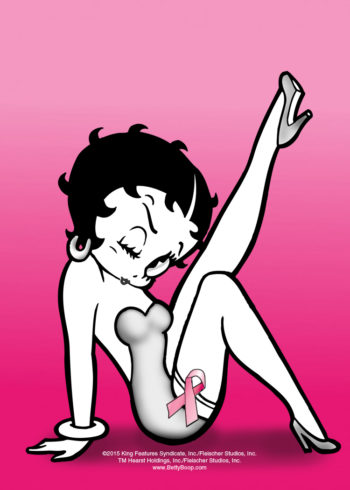 LIFE THREATENING RISKS & LIFE SAVING PROCEDURES
LIFE THREATENING RISKS & LIFE SAVING PROCEDURES
Welcome everyone! Today is FACTUAL FRIDAY – and in Honor of BREAST CANCER AWARENESS MONTH – this week’s Blog is dedicated to saving the Lives of Women everywhere.
And as I do every year, my co-host for this particular Blog is the iconic and beloved BETTY BOOP.
As most of you know by now, my hubby Mark Fleischer is the CEO of our family owned business FLEISCHER STUDIOS. And, Betty Boop has been a part of our family and our business for over 80 years!
So, I’m thrilled when Betty pops over from the studio to help me deliver a message that is VITAL to women the world over.
You see, breast cancer affects about 220,000 women every year. I know! That’s just incredible! In fact, this cancer is the most commonly diagnosed cancer among women. And, ten years ago I was one of those 220,000 women when I was diagnosed with breast cancer.
Moreover, several women in our extended family also have been diagnosed with the disease – AND fortunately, have survived.
BUT, in order to survive and treat breast cancer successfully, we have to detect it early. And to do that, we need to know what our risks are and what screening procedures we need to undergo.
So, please come with Betty and Me as we review the most COMMON RISK FACTORS FOR BREAST CANCER:
1) GENDER. That’s right. BOTH men and women can get breast cancer. However, it occurs approximately 100 times more often in women than men.
2) AGE. Like most cancers, our risk increases as we get older. Typically, breast cancer affects women over the age of 55.
3) RACE. With a few exceptions, most types of breast cancer (remember, there are many) are more common among Caucasian women than women of other races.
4) MENSTRUAL AND REPRODUCTIVE HISTORY. In short, the longer our cycle of menstruation lasts, the greater our risk for breast cancer becomes. In addition, women who have never had children or who had a child at a later age also have an increased risk for the disease.
5) FAMILY MEDICAL HISTORY. Women who have a first degree relative – a parent, sibling or child – who had breast cancer have an increased risk for developing the disease as well.
6) PERSONAL MEDICAL HISTORY. For those of us who have already experienced one breast cancer like myself, our risk of developing another breast cancer is greater.
7) FIBROSIS. This is a condition in which the breast tissue is very dense. This was my primary risk factor for breast cancer. And, not only does it increase our risk for the disease, but it also makes it more difficult to diagnose the disease.
8) GENETIC ANOMALY. Now, most of us are familiar with the BRCA1 and BRCA2 genes. If these genes carry a mutation – or anomaly – one’s risk for breast cancer increases significantly. If you have a family history of breast cancer or if you are of Ashkenazi Jewish descent, you may have an anomaly of these genes. And if so, your risk for both breast cancer and ovarian cancer is greater.
Now, come with Betty and Me as we discuss the ESSENTIAL SCREENING PROCEDURES for detecting breast cancer early:
1) MAMMOGRAM. This simple procedure saved my life! It can save yours too! The guidelines for this exam keep changing. So, be sure to consult with your primary care physician. The age at which one begins this exam and the frequency of follow-ups depends upon YOUR PERSONAL RISK.
2) SCREENING ULTRASOUND. This is a specific ultrasound that helps detect breast anomalies in women who have fibrosis. It can be conducted on the same day as one’s mammogram. I know. I do this every year.
3) SELF EXAM. It’s so important to know the basics of a self- examination. While instructions can be found on many venues, it’s best to have your physician walk you through the proper steps.
4) OFFICE EXAM. I always schedule an appointment with my physician six months after my mammogram and ultrasound. I refer to this as “the six-month split,” a ritual which ensures that my breasts are examined twice a year by a professional – instead of just once.
And remember, with all cancers our BEST DEFENSE IS A STRONG OFFENSE. We need to be PROACTIVE. We need to be INFORMED. We need to be DILIGENT.
For while we may not be able to totally prevent breast cancer, we can CATCH IT EARLY and TREAT IT SUCCESSFULLY!
Betty and I can’t thank you all enough for joining us today. This is an issue that affects all of us. We are all in this together. And, as WOMEN we all need to be WELLNESS WARRIORS – fighting our way to VICTORY!
FROM BETTY AND ME, we thank everyone for joining us today. We send LOVE to women everywhere who are battling the disease – and to those who have overcome the odds and have survived!
Until next time, WEAR YOUR PINK PROUDLY, stay in GOOD HEALTH and . . .
TAKE THE COURSE AND TAKE CHARGE!
HELPFUL LINKS:
NATIONAL BREAST CANCER FOUNDATION



A third of all women and men diagnosed with breast cancer will go on to progress to stage 4 breast cancer. (metastatic), regardless of whether or not it was detected early. 113 women and men die every single day in the United States alone from metastatic breast cancer. That number has not changed in the last 30 years. If Komen was doing what they originally set out to do, there should have been SOME progress in the death rate in the last 35 years. They care not for the sickest among us.
TY Lillian ~ I agree. We should be seeing more progress. I wish we had more good news. There is a new study in which 72 new breast cancer mutations have been identified. If we add these to the mutations we already know – like the BRCA1 and BRCA2 – we should be able to fill in the puzzle more completely. What really causes breast cancer? Who really is at risk? At least I hope this is the case. I hope this research helps all of us. Women and men. We have no choice but to wait and see. If you’re interested, it was published in the journals Nature and Nature Genetics. Thanks so much for caring and speaking out. Best, S.